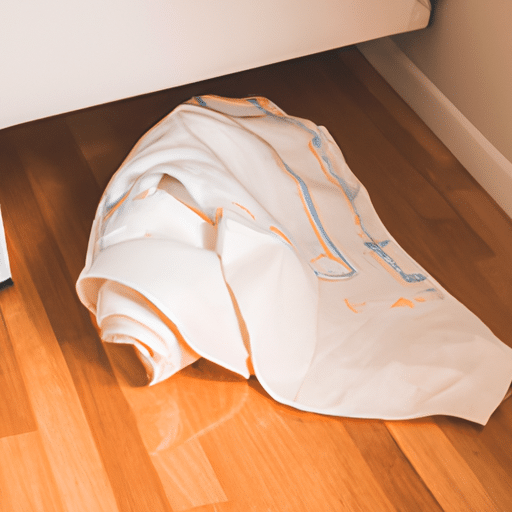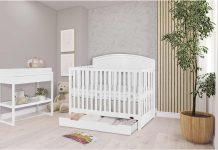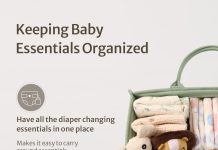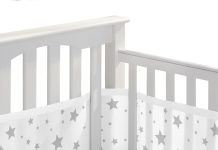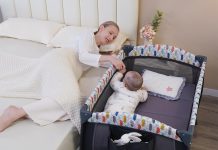In the ever-changing world of parenting, there is one question that often arises: should you change a baby on the floor or table? With varying opinions and conflicting advice, it can often be difficult for new parents to navigate this decision. In this article, we will explore the pros and cons of both options to help you make an informed choice that suits your family’s needs.
Review contents
Hygiene Considerations
Cleanliness of the Surface
When it comes to changing a baby, one of the most important considerations is the cleanliness of the surface where the diaper change will take place. Whether you choose to change your baby on the floor or a table, it is crucial to ensure that the surface is clean and free from any contaminants. Regularly wiping down the surface with a disinfectant and using a fresh changing pad for each diaper change can help maintain a clean and hygienic environment for your baby.
Availability of Cleaning Supplies
Another essential aspect to consider is the availability of cleaning supplies. If you opt to change your baby on a table, make sure you have all the necessary cleaning supplies within reach. This includes wipes, hand sanitizer, and disposal bags for dirty diapers. On the other hand, if you decide to change your baby on the floor, ensure that you have a designated changing station stocked with these supplies nearby. Having easy access to cleaning supplies will make the diaper changing process both efficient and hygienic.
Comfort for the Baby
The comfort of your baby should also be taken into account when deciding whether to change them on the floor or a table. Some babies may feel more at ease lying on a padded changing table, while others might prefer the feeling of being on a soft, clean floor surface. Observing your baby’s reactions and adjusting accordingly can help create a more comfortable and pleasant diaper changing experience for both you and your little one.
Convenience
Accessibility of the Surface
Accessibility plays a significant role when it comes to changing a baby’s diaper. A changing table provides a raised surface that allows easy access to all the necessary supplies without bending over. This can be particularly beneficial for parents who have back or mobility issues. On the other hand, changing your baby on the floor can be more accessible if you don’t have a designated changing table. It provides a lower surface that requires less bending and may be more convenient in situations where a changing table is not readily available.
Mobility of the Baby
Consider your baby’s mobility when deciding whether to change them on the floor or a table. Newborns and infants who are unable to roll over or wiggle around may be more easily managed on a table with safety straps. However, as your baby grows and becomes more mobile, changing them on the floor can offer a safer option. It minimizes the risk of falls or injuries that may occur if your baby were to roll off a changing table or wriggle out of their safety straps.
Space Constraints
Space constraints should also be taken into consideration. If you have limited space in your home or diaper changing area, changing your baby on the floor can be a more practical choice. It requires less space and allows for greater flexibility in arranging the changing station to fit your surroundings. On the other hand, if you have ample space and prefer a dedicated area for diaper changes, a changing table can offer a more organized and convenient solution.
Safety
Stability of the Surface
The stability of the surface used for diaper changes is crucial for the safety of your baby. Changing tables are specifically designed to provide a stable and secure surface for diaper changes. They often come equipped with safety features such as raised edges and safety straps to prevent your baby from rolling off. On the other hand, when changing your baby on the floor, ensure that the surface is flat and stable to avoid any accidents or injuries.
Risk of Falls or Injury
The risk of falls or injury should be carefully evaluated when deciding whether to change your baby on the floor or a table. Changing tables offer a higher level of safety as they provide a confined space with safety features. However, if your baby is particularly active or likes to roll around, changing them on the floor may be a safer option to prevent falls from elevated surfaces. It is important to always keep a hand on your baby and never leave them unattended, regardless of where you choose to change them.
Parental Supervision
Whether you choose to change your baby on the floor or a table, parental supervision is crucial for your baby’s safety. Always stay within arm’s reach and maintain constant supervision during diaper changes. This helps ensure the safety of your baby and allows you to quickly respond to any potential hazards or accidents that may arise. Remember, accidents can happen in seconds, so it’s important to prioritize your baby’s safety at all times.
Health and Ergonomics
Back and Posture Support
Considering the health and ergonomics of both yourself and your baby is vital during diaper changes. Changing tables often provide a more comfortable height for parents, reducing the strain on their back and posture during diaper changes. This can be especially beneficial for parents with preexisting back issues or those recovering from childbirth. However, if you have a comfortable surface on the floor, it can also provide adequate support for your back and posture when changing your baby’s diaper.
Prevention of Cross-Contamination
Preventing cross-contamination is a significant aspect of maintaining good hygiene during diaper changes. Changing tables typically provide a designated space for diaper changes, which minimizes the risk of transferring germs or contaminants to other surfaces. Regularly cleaning and disinfecting the changing pad or cover can further help prevent cross-contamination. Likewise, if you choose to change your baby on the floor, ensure that the area is clean and consider using a designated changing pad or mat to maintain hygiene and minimize cross-contamination.
Reducing Distractions for the Baby
Creating a calm and distraction-free environment during diaper changes can help keep your baby content and cooperative. Changing tables offer a controlled space where distractions can be minimized. With limited visual stimuli, your baby may be more focused on the task at hand, leading to a quicker and smoother diaper change. However, if you choose to change your baby on the floor, you can still create a suitable environment by reducing noise, dimming lights, and using calming techniques to keep your baby engaged and comfortable.
Age and Development Stage of the Baby
Newborns and Infants
When dealing with newborns and infants, the choice between changing on the floor or a table may largely depend on personal preferences and practicality. Newborns are typically less mobile and may find the secure and elevated surface of a changing table soothing. On the other hand, changing your baby on the floor may provide a more intimate and bonding experience, allowing you to engage with your baby at eye level.
Crawlers and Toddlers
Once your baby starts to crawl and explore their surroundings, changing them on the floor may become more practical and safe. Crawlers and toddlers tend to be more active and may resist being confined to a changing table. By changing them on the floor, you eliminate the risk of falls from an elevated surface and allow them the freedom to move around while you attend to their diapering needs.
Walking and Climbing Toddlers
As your baby transitions from a crawler to a walking and climbing toddler, changing them on the floor may still be the safer option. Toddlers at this age are often full of energy and more prone to accidents. They may try to climb off a changing table or wriggle out of safety straps. By choosing to change them on the floor, you can minimize the risk of falls and injuries while maintaining a safe and comfortable environment for your little explorer.
Changing Location Considerations
Public Places
Changing diapers in public places can pose unique challenges. Many public restrooms are equipped with changing tables, providing a designated space for diaper changes. However, the cleanliness and availability of these facilities may vary. If you choose to use a public restroom changing table, ensure that it is clean and take necessary precautions to maintain hygiene. Alternatively, changing your baby on the floor by using a portable changing pad or mat can offer a more reliable and hygienic option, especially if clean and accessible restroom facilities are limited.
Home Environment
In the comfort of your own home, you have more control over the changing location. Choosing to change your baby on a changing table in their nursery or a designated changing area can provide a more organized and convenient solution. You can ensure that the surface is clean and well-stocked with all the necessary supplies. However, if you prefer to change your baby on the floor, make sure to create a designated changing station that is easily accessible and equipped with the essential cleaning supplies.
Outdoor Settings
Changing diapers in outdoor settings can present its own set of challenges. When outdoors, it may be more practical to change your baby on the floor, especially if changing facilities are not readily available. To ensure hygiene, use a portable changing pad or mat and scout for a clean and secluded area away from direct sunlight or harsh weather conditions. Remember to pack an adequate supply of cleaning supplies and disposal bags to maintain a hygienic environment for your baby and minimize the risk of exposure to germs and contaminants.
Personal Preferences
Cultural Factors
Personal preferences for changing a baby on the floor or a table can be influenced by cultural factors as well. Cultural practices and beliefs vary around the world, and these can play a role in the choice of diaper changing location. Some cultures may have specific preferences or customs regarding where and how babies should be changed. Understanding and respecting cultural factors can help guide your decision-making process and ensure that you create a comfortable and appropriate environment for your baby.
Individual Comfort
Ultimately, individual comfort plays a significant role in deciding whether to change a baby on the floor or a table. As parents or caregivers, it’s essential to feel comfortable and confident in your chosen method of diaper changing. Consider factors such as ease of access, convenience, and personal preferences when making this decision. Remember, a more comfortable and relaxed parent or caregiver is likely to provide a better experience for both themselves and the baby during diaper changes.
Availability of Changing Facilities
The availability of changing facilities is another crucial element to consider. When out and about, the presence of available and clean changing tables in public restrooms can greatly influence your decision. If clean and accessible changing tables are readily available, using them can provide a convenient and hygienic solution. However, if changing facilities are limited or not up to standard, changing your baby on the floor may be a safer and more reliable option. Always prioritize the well-being and comfort of your baby when making this decision.
Risk of Exposure to Germs and Contaminants
Public Restrooms
Changing a baby’s diaper in public restrooms can expose them to germs and contaminants. While some public restrooms provide clean and sanitized changing tables, others may not meet the hygiene standards you desire. In such cases, changing your baby on the floor using a portable changing pad or mat can help minimize the risk of exposure to germs and contaminants. Remember to maintain good personal hygiene by washing your hands thoroughly after each diaper change, regardless of where it takes place.
Floors in Public Spaces
Floors in public spaces can harbor germs and contaminants that may pose a risk to your baby’s health. When changing your baby on the floor in public places, it’s crucial to ensure that you use a clean and designated changing pad or mat. This creates a barrier between your baby and the surface, reducing the risk of direct contact with any potential germs or contaminants. Additionally, regularly disinfecting the changing pad or mat can help maintain a hygienic environment for your baby.
Germs Present on Tables
While changing tables are designed to provide a clean and hygienic space, it’s essential to remember that they can harbor germs and contaminants as well. Regularly cleaning and disinfecting the table, along with using a fresh changing pad for each diaper change, can help reduce the risk of exposing your baby to harmful germs. By practicing good hygiene habits, regardless of the surface you choose, you can minimize the risk of your baby being exposed to harmful contaminants.
Potential Disturbance for the Baby
Noise and Busy Environment
The noise and environment in which you change your baby’s diaper can impact their comfort and cooperation. Changing tables in public restrooms may be situated in busy areas with loud noises and distractions. This can sometimes lead to a fussy and unsettled baby during diaper changes. On the other hand, changing your baby on the floor, particularly in a calm and familiar environment, can help create a quieter and more soothing atmosphere. Minimizing noise and distractions can help keep your baby relaxed and make the diaper changing experience less disruptive.
Temperature Variation
Temperature variation is another factor to consider when changing your baby’s diaper. Changing tables in public restrooms may be situated in areas with varying temperatures, such as near air conditioning vents or open windows. This can expose your baby to sudden temperature changes and discomfort during the diaper change. Changing them on the floor in a controlled environment allows you to ensure a comfortable temperature for your baby, minimizing any potential discomfort or disturbance.
Visual Stimuli
Visual stimuli can also influence your baby’s behavior during diaper changes. Changing tables in public restrooms may be surrounded by bright lights, mirrors, or other visually stimulating elements. While some babies may find these stimuli fascinating, others may become easily distracted or overwhelmed. Changing your baby on the floor can provide a more subdued setting, reducing visual distractions and allowing for a more focused and relaxed diaper change.
Conclusion
When it comes to changing a baby’s diaper, the decision between using the floor or a table ultimately depends on a variety of factors. Hygiene considerations, convenience, safety, health and ergonomics, the baby’s age and development stage, location considerations, personal preferences, and the risk of exposure to germs and contaminants are all important factors to take into account. By carefully considering each factor and weighing the pros and cons, you can make an informed decision that ensures the comfort, safety, and well-being of both you and your baby during diaper changes. Remember, each baby and caregiver is unique, so it’s important to tailor your approach to suit your specific needs and circumstances.

